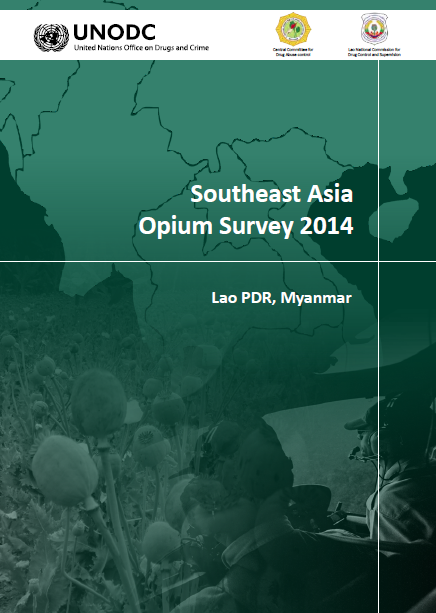Southeast Asia Opium Survey 2014 – Lao PDR, Myanmar
By United Nations Office on Drugs and Crime • December 10, 2014The roots of the opium production problem in Southeast Asia go back to the 19th century. The region is home to the “Golden Triangle”, an area long associated with opium and heroin production, located where the borders of Myanmar, Lao People’s Democratic Republic (Lao PDR) and Thailand converge along the Mekong River. Twenty years ago, the Golden Triangle was the largest heroin‐producing area in the world, supplying the region’s own demand as well as exporting its surplus to North‐east Asia, Europe and the United States of America. In the 1990s and early 2000s, national and regional efforts succeeded in reducing both opium production and trade in the region, though they subsequently increased.
UNODC started annual Opium Surveys in Lao PDR in 2000, and Myanmar in 2002, in order to measure trends in the cultivation of opium poppy and help formulate an effective response to it. The surveys undertaken from 2000 to 2006 underscored the fact that efforts to counter opium production had succeeded in eliminating much of the cultivation in the Golden Triangle, but more recent opium surveys have indicated a resurgence in production over the last few years. As the Southeast Asia region also continues to include high levels of demand, the large quantities of opium produced provide opportunities for transnational crime networks and pose a challenge to the stability and development of the region.
Opiate trafficking in Southeast Asia
According to the Organisation for Economic Cooperation and Development (OECD), average annual economic growth in Southeast Asia is back to its pre‐crisis levels of 6.0%. As Southeast Asia is set to establish the ASEAN Community in 2015,3 the region is well positioned to continue this growth trend. However, economic analysis does not specifically take into account the growing threat to the region posed by transnational organized crime (TOC), which, according to conservative estimates, exceeds a value of US$ 90 billion per year.4 The production and trafficking of opiates in the region, mainly in the refined form of heroin, constitutes a large proportion of the money flows emanating from these illicit activities.
The scope of the threat
Although the majority of opium production in Southeast Asia is confined to parts of Myanmar, particularly Shan State, a smaller, yet significant, amount is also produced in Lao PDR. The 2014 Opium Survey reported no significant changes in opium production in Myanmar and Lao PDR from 2013: the total combined area under opium cultivation in the two countries was estimated to be 63,800 hectares in 2014, compared to 61,700 hectares in 2013.
The two countries produced an estimated combined total of 762 tons of opium in 2014, which would most probably have been refined into heroin close to source using the precursor chemical acetic an hydride, which is sourced outside the Golden Triangle. Based on this total, the amount of heroin of unknown purity produced in Myanmar and Lao PDR in 2014 totaled some 76 tons.
The relationship between demand and supply is not entirely linear, but demand for heroin may be linked in part to the resurgence in opium production in Southeast Asia in the past half‐decade.
China accounts for approximately 70% of heroin users in Asia, and is the largest single heroin market in the world. The absolute number of heroin users in China increased by approximately half a million between 2007 and 2013, with the number of users estimated to be over 1.3 million. But due to a surge in methamphetamine use over that period, heroin use as a proportion of all registered drug users actually declined. An increase in heroin use was also reported in Lao PDR, Singapore and Thailand in 2014. Heroin remains the primary drug of concern in Malaysia, Myanmar, Singapore and Viet Nam, and continues to account for a substantial number of the problem drug users in Australia, Indonesia, Myanmar and Singapore.
Estimates suggested that there were over 3.3 million opiate users in East and Southeast Asia in 2014 (table 1),14 a number that may rise as the populations of countries in the region increase and if current trends continue. Moreover, as most countries in the region do not regularly conduct national drug‐use surveys, these estimates are limited. In particular, there remains substantial uncertainty about the number of users in China, where estimates are solely derived from data on government‐registered users.
Based on the average price of heroin in Southeast Asia, the trade in opiates and heroin in the region was estimated to exceed $16.3 billion per year in 2014. These large money flows have severe negative impacts, undermining the rule of law and requiring Governments to allocate resources that could otherwise be used for development and public services. As regional integration includes reducing trade restrictions and the facilitating of transportation across borders, the threat emanating from the trade in opiates may increase further.
Download the full report here.
Tags: Asia, China, Drugs Trafficking, Golden Triangle, Livelihood, Opium, United Nations Office on Drugs and CrimeThis post is in: Drugs, Spotlight
Related Posts









 All posts
All posts